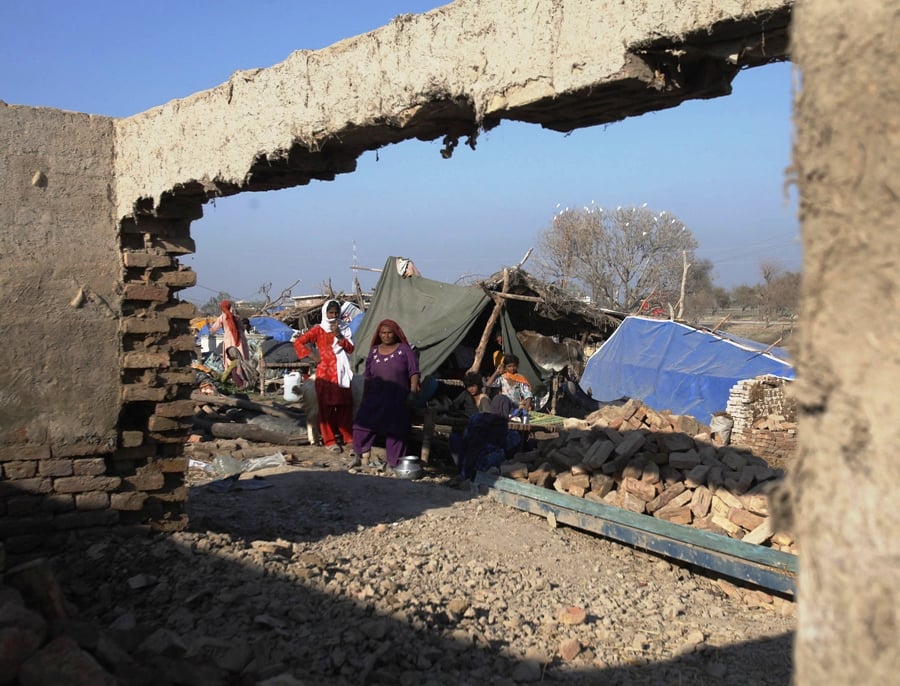
Let down by their unpopular government, and too poor to rebuild their homes, villagers living in tents can only pray the next monsoon season in July won't bring more upheaval.
"We are hardly getting any help," said Alimi Khoso, pointing to a dirty plaster around her two-month-old granddaughter's leg, broken in an accident in a tent camp.
"Where will we go if there are more floods. We don't even have enough money to run away."
Monsoon floods began roaring through Pakistan in late July last year, leaving about 11 million people homeless.
The government was slow to respond while the military, seen as a far more efficient institution, took the lead in relief operations. Pakistani leaders could face fresh criticism if dire conditions in flood-affected areas worsen.
Many communities in Sindh are still surrounded by floodwaters and hundreds of thousands of people still live in temporary shelters, even though more than $1 billion in flood aid has been delivered to Pakistan, a strategic U.S. ally.
In Ramli Khosa, about 1,5OO people reside in rows of bare, white tents donated by Arab and Western aid groups.
They must travel about a kilometre to fetch water in tough conditions felt in many flood-affected parts of Sindh province, which was hardest hit by the disaster.
In interviews in several villages only a few people said they received compensation from authorities -- 20,000 rupees.
That doesn't go far. Prices remain unbearably high after floods destroyed crops and cut food supplies.
Farmers say it could be years before they are able to plant again. To survive, some toil as labourers, earning about a dollar a day. Government help is unlikely to come soon.
Pakistan's government has been preoccupied by political crises and already faces a host of other problems, from power cuts to a stubborn Taliban insurgency.
Even if it decides to step up efforts to help millions of flood victims who sank deeper into poverty after the catastrophe, generating enough funds will be difficult.
Without implementing painful economic reforms, the government will keep struggling to secure the sixth tranche of an $11 billion IMF loan propping up the economy.
"The flood issue adds to the government's long list of woes. The state is already stretched in many directions," said Kamran Bokhari, South Asia director at STRATFOR global intelligence.
People like Qurban Ali have been largely forgotten both at home and abroad.
Ali stood over some bricks -- what's left of his flattened house -- glued together with a mixture of sand and cement to form a small frame, a tiny step towards recovery.
"How can I plan to rebuild it without any help from the government,' he asked, as mangy dogs lingered nearby.
A group of angry men held up a document which promised a local official would deliver six sacks of staple foods. He delivered only three and demanded a bribe, they alleged.
Ruling Pakistan People's Party spokeswoman Fauzia Wahab said the government was doing its best to help flood victims.
"We are providing the farmers free-of-cost fertiliser and seeds. But as you know we still have a problem with cash," she told Reuters.
Medicine is too expensive
Resentment is also growing elsewhere in Sindh, home province of President Asif Ali Zardari.
In Murad Chandio village, Pakistan Red Crescent volunteers unload sacks of flour from a truck as dozens of people who returned only a month ago line up for help. It may temporarily ease suffering. People there want long-term stability, and that can only come from the government.
Families live beside wreckage, protected only by blankets hanging above them. It's easy to see why many are terrified at the thought of new raging waters.
"People's resilience has been really affected. Even any low level flooding in future is going to be a problem. They may not be able to cope," said Penny Sims, a Red Cross spokeswoman.
The ripple affects of the floods are felt most acutely in the downtrodden parts of Sindh.
Economic devastation has left families unable to care for their neediest loved ones. Ten-year-old Gulbahar Hidayatullah's bone disease, rickets, is inflicting even more pain because relatives can't afford to buy her enough medicine to treat it.
While some youngsters pass time playing beside the destruction left by the floods, a relative has to hold her up.
Other children have been set back in different ways. In Ramli Khoso, an 85-year-old toothless woman named Allahrakhi walked barefoot with a tree branch she uses as a cane.
She barely had the energy to express her biggest worry -- her grandson may be deprived of an education because floods have kept him out of the classroom.
"I want him to have money so he can go to school, so he can get married one day," she said, trembling. Others worry about just getting their children through the next few weeks or months.
In Adam Khan village, located beside a canal with stinking, stagnant water left by the floods, a woman lies in a tent. She gave birth there a day earlier without medical attention because the cost of transport to a clinic was too steep.
The infant yawns in the heat, flies swirling over her sweaty face.









1732012115-0/Untitled-design-(14)1732012115-0-270x192.webp)












COMMENTS
Comments are moderated and generally will be posted if they are on-topic and not abusive.
For more information, please see our Comments FAQ